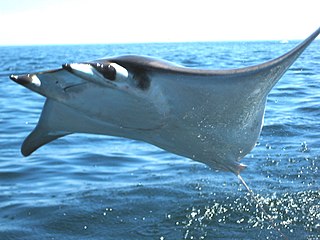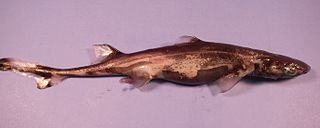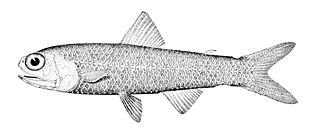| Ahliesaurus | |
|---|---|
| Scientific classification | |
| Kingdom: | Animalia |
| Phylum: | Chordata |
| Class: | Actinopterygii |
| Order: | Aulopiformes |
| Family: | Notosudidae |
| Genus: | Ahliesaurus Bertelsen, G. Krefft & N. B. Marshall, 1976 |
Ahliesaurus is a genus of waryfishes.
| Ahliesaurus | |
|---|---|
| Scientific classification | |
| Kingdom: | Animalia |
| Phylum: | Chordata |
| Class: | Actinopterygii |
| Order: | Aulopiformes |
| Family: | Notosudidae |
| Genus: | Ahliesaurus Bertelsen, G. Krefft & N. B. Marshall, 1976 |
Ahliesaurus is a genus of waryfishes.
There are currently two recognized species in this genus: [1]

Manta rays are large rays belonging to the genus Mobula. The larger species, M. birostris, reaches 7 m (23 ft) in width, while the smaller, M. alfredi, reaches 5.5 m (18 ft). Both have triangular pectoral fins, horn-shaped cephalic fins and large, forward-facing mouths. They are classified among the Myliobatiformes and are placed in the family Myliobatidae.

Mobula is a genus of rays in the family Mobulidae found worldwide in tropical and warm, temperate seas. Some authorities consider this to be a subfamily of the Myliobatidae. Their appearance is similar to that of manta rays, which are in the same family, and based on genetic and morphological evidence, the mantas belong in Mobula. Species of this genus are often collectively referred to as "devil rays", "flying mobula", or simply "flying rays", due to their propensity for breaching, sometimes in a spectacular manner. Depending on the exact species, the devil rays can attain widths up to 1.1–5.2 m (3.6–17.1 ft), the largest being second only to the manta rays in size, which can reach 5.5–7.0 m (18.0–23.0 ft). Despite their size, little is known about the devil rays, much of it being from anecdotal accounts, whereas the manta rays are better known. Most species entirely lack a tail stinger. In most species having a stinger, it is encased, rendering it harmless; only M. mobular has a "free" stinger.

The footballfish form a family, Himantolophidae, of globose, deep-sea anglerfishes found in tropical and subtropical waters of the Atlantic, Indian, and Pacific Ocean. The family contains c. 22 species all in a single genus, Himantolophus.
Günther Edmund Maul was a German ichthyologist and taxidermist in Portugal. Maul came to Madeira in December 1930 to work as taxidermist at Museu Municipal do Funchal, which opened to the public in 1933. He was appointed director for the museum in 1940, a post that he held to his retirement in 1979. He, however, continued his research until shortly before his death. He started two journals and opened the museum's aquarium to the public in 1959. He also participated in several expeditions including with the French bathyscaphe Archimède in 1966 and organised the first multidisciplinary expedition to the Salvage Islands in 1963. He was awarded an honorary doctorate from the University of Madeira in 1995.

Saccopharynx is a genus of deep-sea eels with large mouths, distensible stomachs and long, scaleless bodies. Commonly, these fish are called gulpers or gulper eels. It is the only genus in the family Saccopharyngidae, and is part of the derived lineage of the "saccopharyngiforms," which includes other mid-water eel species. The name is from Latin saccus meaning "sack" and Greek φάρυγξ, pharynx.

Monognathus, or onejaw, is the only genus of the family Monognathidae of deep-sea eels. The name comes from the Greek monos meaning “one” and gnathos meaning “jaw”, a reference to the large mouth in comparison with the rest of the fish, and also the absence of an upper jaw.

Etmopterus is a genus of lantern sharks in the squaliform family Etmopteridae. They are found in deep sea ecosystems of the Atlantic, Indian and Pacific Oceans.

Calliostomatidae is a family of sea snails within the superfamily Trochoidea and the clade Vetigastropoda.

Emydura, the Australian short-necked turtles, are a genus of turtles in the family Chelidae. It was paraphyletic with Elseya. Consequently, it was split into two genera Myuchelys and Elseya by Thomson & Georges, 2009. They can grow quite large, 30 cm or more is not unusual and have a life span of around 20–30 years. They generally do not hibernate as their warmer climate lets them remain active all year round; they also spend more time in the water than other varieties. They are considered omnivore but rely on a constant supply of meat to remain healthy, feeding on basically anything that will fit into their mouth.

The red-bellied short-necked turtle, pink-bellied side-necked turtle, or Jardine River turtle is a species of turtle in the family Chelidae.

Gigantactis is a genus of deep-sea fish of the family Gigantactinidae. The species in this genus are poorly known and found in all oceans, at depths of 1,000–2,500 metres (3,300–8,200 ft). The most striking feature of these fish is extremely enlarged first filament of dorsal fin, called the illicium, with bioluminescent photophore at its end.
Holtbyrnia is a genus of tubeshoulders.

The reef manta ray is a species of ray in the family Mobulidae, one of the largest rays in the world. Among generally recognized species, it is the second-largest species of ray, only surpassed by the giant oceanic manta ray.
Scopelosaurus is a genus of waryfishes.

Lampadena is a genus of lanternfishes.

Linophryne is a genus of leftvents, commonly called the "bearded seadevils."

Oneirodes is a genus of fish in the family Oneirodidae.
Parataeniophorus is a genus of flabby whalefishes that was formerly included in the no longer recognized tapetail family Mirapinnidae.
Emydocephalus is a genus of sea snakes in the family Elapidae. Unlike most sea snakes, all species of Emydocephalus, have an absence of teeth on their dentary and palatine bones, and lack venom. The dentary and palantine bones bear only a row of papillae. Emydocephalus does, however, bear fangs and many small pterygoid teeth. This reduced dentition is due to their diet consisting almost entirely of fish eggs.